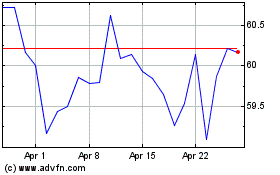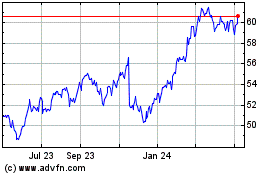Can Retailers Keep Paces With Shoppers?
March 17 2018 - 8:29AM
Dow Jones News
By Sarah Nassauer
Can traditional retailers keep pace with consumers as they
increasingly use technology to shop? That is the question
confronting hundreds of executives as they gather in Las Vegas this
week.
After one of the strongest winter holiday shopping periods in
years, many retail chains find themselves in a position of relative
strength compared with where they stood a year ago. A strong
economy and high employment has Americans willing to spend, but
they are visiting stores less often and increasingly using
smartphones to check prices or just check out.
At the Shoptalk industry conference starting Sunday, executives
from retail and technology, including Amazon.com Inc., Google,
Macy's Inc. and Walmart Inc., will meet to discuss how they will
navigate the coming year.
"It's the first time in a very long time when it feels like the
wind is at our back as an industry versus we have to walk into very
strong headwinds," said Steve Barr, leader of the retail and
consumer sector at consulting firm PwC.
In the most recent quarter, Target Corp., Macy's, Best Buy Co.
and Walmart said an overall a strong economy and solid holiday
spending helped revenue growth. Retailers finally have the money to
get basics right -- customer service, store remodels and better
technology -- details that will help traditional chains compete
with each other and online, said Mr. Barr.
"The elephant in the room is Amazon, but there is no single
technology or magic potion that is going to instantly provide a
solution."
Amazon's purchase of Whole Foods last year put in motion a race
for brick-and-mortar retailers to add home delivery services and
for Amazon to increase sales in categories traditionally sold from
stores. Walmart said Wednesday it plans to offer home delivery of
groceries in 100 metro areas by year's end. Target, Kroger Co, and
Costco Wholesale Corp are adding more cities and products to their
home grocery delivery services.
Higher consumer spending and lower corporate tax rates have
helped retailers spend on new technology and improving stores. But
profit pressures remain and any perceived bump on the road to
compete with Amazon can hurt.
Online sales growth slowed at Walmart in the most recent
quarter, though overall sales were strong and Walmart has made big
moves to grow online, including buying online retailer Jet.com for
$3.3 billion. The day of the earnings announcement, Walmart's stock
fell more than 10%, the biggest one-day drop in the price since
1988. Walmart executives have said they are still on track to
achieve 40% U.S. e-commerce sales growth in the current fiscal
year.
Retailers should focus on pleasing customers, not just beating
Amazon or keeping up with Walmart's investments in the space, said
Brendan Witcher, vice president at Forrester Research. "The reality
is they aren't usually behind their competitors. They are behind
their customer," he said.
"If you don't understand your customer there is no technology in
the world that is going to save you."
Last week, the industry had a stark reminder when Toys "R" Us
Inc. set plans to close all its U.S. stores, succumbing to a hefty
debt load that limited its ability to compete with both Amazon and
discounters.
Write to Sarah Nassauer at sarah.nassauer@wsj.com
(END) Dow Jones Newswires
March 17, 2018 08:14 ET (12:14 GMT)
Copyright (c) 2018 Dow Jones & Company, Inc.
Walmart (NYSE:WMT)
Historical Stock Chart
From Mar 2024 to Apr 2024

Walmart (NYSE:WMT)
Historical Stock Chart
From Apr 2023 to Apr 2024
